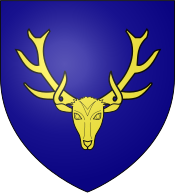Earldom of Cromartie
| Coat of arms of the Earl of Cromartie | |
|---|---|
 |
|
| Details | |
| Armiger | The Rt. Hon. The Earl of Cromartie |
| Crest | A mountain in flames Proper |
| Escutcheon | Azure, a deer's head cabossed Or |
| Supporters | On a compartment embellished with stag's horn club moss two savages wreathed about the head and middle each holding in the exterior hand a baton resting on the shoulder burning at the end and the hair likewise enflamed all Proper |
| Motto | LUCEO NON URO |
Earl of Cromartie ( /ˈkrɒmərti/) is a title that has been created twice, both times for members of the Mackenzie family. This branch of the family descends from Sir Roderick Mackenzie, whose elder brother Kenneth Mackenzie was created Lord Mackenzie of Kintail in 1609 and was the father of Colin Mackenzie, 1st Earl of Seaforth (see the Earl of Seaforth for further history of this branch of the family). Sir Roderick's son, John Mackenzie, was in 1628 created a baronet, of Tarbat in the County of Ross, in the Baronetage of Nova Scotia, with remainder to his heirs male whatsoever. He was succeeded by his son, Sir George Mackenzie, 2nd Baronet. He was a prominent statesman and judge and served as Lord Justice General from 1678 to 1680 and from 1704 to 1710 and as Secretary of State from 1702 to 1704. In 1685, he was raised to the Peerage of Scotland as Lord MacLeod and Castlehaven and Viscount of Tarbat. In 1703 he was further honoured when he was made Lord MacLeod and Castlehaven, Viscount of Tarbat and Earl of Cromartie. In 1704, Lord Cromartie resigned his baronetcy in favour of his second son the Hon. Kenneth Mackenzie (died 1728), who was created a baronet, of Cromarty and Grandvale (see Mackenzie baronets).
He was succeeded in the peerages by his eldest son, the second Earl. On his death, the titles passed to his eldest surviving son, the third Earl. He supported the Jacobite rebellion of 1745 and led a force of 400 men from Clan Mackenzie at the Battle of Falkirk in 1746. Lord Cromartie was captured by government forces the same year and pleaded guilty to high treason before the House of Lords. He was sentenced to death but received a conditional pardon in 1749. However, his titles were forfeited. His eldest son and heir apparent, John Mackenzie, Lord MacLeod, fought alongside his father in the rebellion of 1745. He was also convicted of high treason and sentenced to death, but received a full pardon in 1748. He later had a successful career in both the British and Swedish armies. He achieved the rank of Major-General in the British Army, and was created a Count in the Swedish nobility, a title which was recognized by George II. In 1784, his family estates were restored to him by Act of Parliament for a payment of £19,000. Lord MacLeod died childless in 1789.
...
Wikipedia
